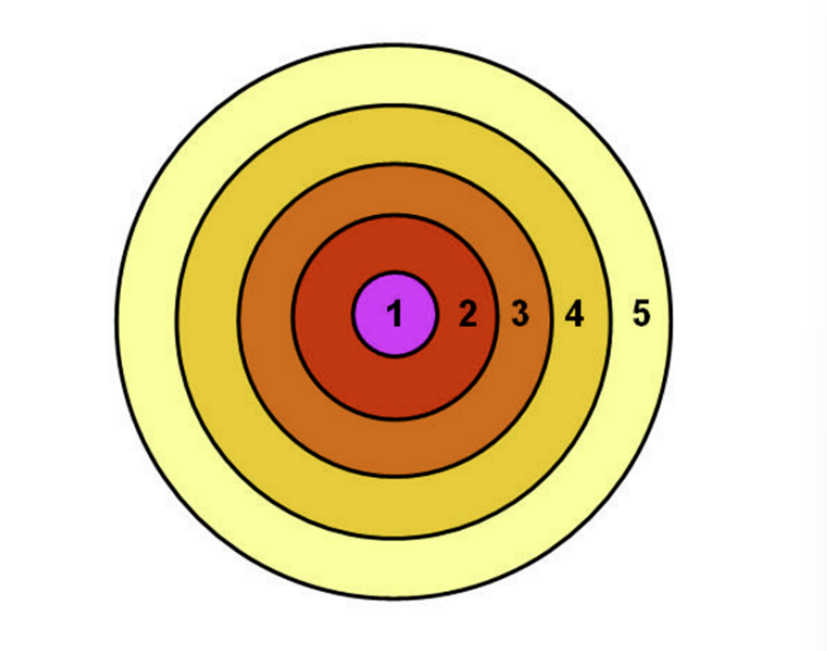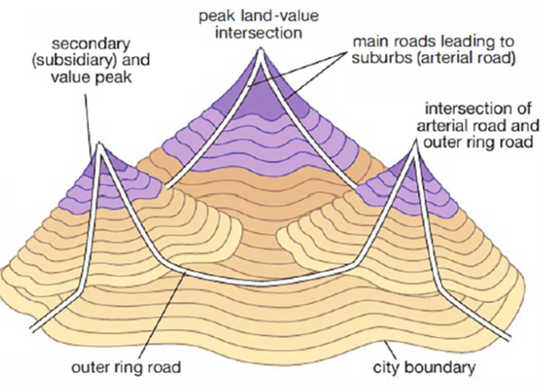Urban Environments
URBAN ENVIRONMENTS
URBANISATION
Urbanisation throughout the years:
1700s: Agricultural Revolution
Increased productivity in farms. Reduced need for large rural workforce. Enabled people to work in other jobs and ‘buy’ food.
1800s: Industrial Revolution
Factories built – using people ‘freed’ from rural areas. Rural to Urban migration.
Late 1800s: Improved Living Condition
Improved medical care & sanitation. Reduced death rates. Rapid ‘natural increase’ – more births than deaths.
Early 1900s: Reduced Birth Rates
Decreased natural growth. Migration mainly from abroad.
Mid 1900s: Movements away from cities
People moved back to the suburbs, back to the countryside.
Definitions:
Urban Sprawl | how cities continue to move outwards to the countryside |
Counter-Urbanisation | the process of people moving out of cities and suburbs into smaller towns or rural areas |
Suburbanisation | where towns grow outwards into the fringes of urban area |
Millionaire City | cities that have over a million residents |
Super City | an extremely large city, metropolis or urban area |
Megacity | a very large city, typically one with a population of over ten million people |
Agglomeration | the concentration of people and economic activities at favourable locations |
Commuting | where people live and work in different settlements travelling to work each day |
Natural Increase | where birth rates are higher than death rates, leading to an increase in population |
Pull Factors | attractions encouraging people to move to an area |
Push Factors | reasons for people wanting to leave an area |
Re-urbanisation | the movement of people back into city centres often after regeneration or re-imaging |
Rural dilation | the process describing how the urban way of life is gradually spreading into rural areas |
Rural-Urban Migration | the movement of people from the countryside to cities |
Urban Regeneration | re-using old parts of cities which have been abandoned |
Urban Re-imaging | changing the image of an area and giving it new purpose or identity |
Urbanisation | an increasing percentage of a country's population living in urban settlements |
Problems of Rapid Urbanisation:
Housing:
Unsafe, informal housing
High levels of poverty & inequality
Transport:
Busy
Causes congestion
Communities:
May lack basic amenities (sanitation, electricity etc.)
Employment:
Informal sectors
High levels of unemployment
Environmental:
Issues such as air pollution and waste management
High levels of crime in urban areas (can be related to unemployment levels)
LAND USE IN URBAN AREAS
Examples of land uses in urban areas:
Residential – housing
Commercial – shops
Industry – factories etc
Green Space
Transport

Diagram to show part of urban areas:
Central Business District (CBD)
Low Class Residential (old inner city area)
Rural – Urban Fringe/High Class Residential
Suburban Ring (inter-war housing to modern suburbs)
Factories/ Industry
Land is not worth the same in all areas of the city. It generally declines in value the further it is from the centre, although there are peak in land values along main transport routes.

Locational Needs:
Retailing & commercial businesses – good public transport system, flat land, good infrastructure to support those commuting in via cars, close to the city centre for footfall
Manufacturing – lots of space, roads for the trucks to bring resources and take products, other factories nearby
Housing (low quality) – build up not out further away from services
Housing (high quality) – closer to city centres & transport, big gardens & driveways, less dense
URBAN CHALLENGES IN HIGH INCOME COUNTRIES
Problems with Rapid Urbanisation in the Developed World
Transport & Road Congestion
Employment & Unemployment
Crime
Environmental
Push Factors: Reasons why people move away from an area
Pull Factors: Reasons why people move to an area
Push Factors | Pull Factors |
|
|
Agriculture:
Food Supply
There are complex global supply chains, which are vunerable to being badly disrupting.
Rising fuel costs, labour shortages due to factors such as COVID and Brexit have made supply even less secure. Large populations in urban areas are most at risk of suffering from shortages.
Surging fuel and food prices have resulted in many households cutting back on food shopping increasing the number of people going hungry – food poverty and hunger increased more during the pandemic, especially among poorer residents.
Foodbanks provided food for millions of people during the pandemic.
Energy:
Most of the energy in developed nations comes from gas, electricity and other solid fuels.
A significant number of buildings are very energy inefficient.
Transport:
Big issues around congestion and sustainability – the number of car journeys are increasing.
The environment and quality of public transport is not always up to standard.
The cities have issues with air quality due to mass use of cars, causing illness and a significant number of deaths each year.
Waste Disposal
Huge amounts of waste are produced due to high populations densities.
A huge proportion of this ends up in landfill.
Segregation
People from different cultures choose to live neighbourhoods close to people in similar ethnic backgrounds – but sometimes are forced to for reasons or being excluded from other areas due to lack of income.
Residents of ethnically diverse backgrounds report higher levels of community cohesion than less diverse areas.
Social Issues: services/housing, poverty/deprivation, ethnic segregation, quality of life, ageing population, terrorism/crime
Environmental Issues: ecological footprint, pollution/waste, resources, green space, hazards, sustainability
Economic Issues: deindustrialisation, globalisation, food supply, transport/traffic, energy supply, service provision
URBAN CHALLENGES IN THE DEVELOPING AND EMERGING WORLDS
Urban Pollution
Big issues with water pollution – many rivers and streams used for waste disposal.
Levels of viruses thousands of times high than international safety standards – leading to severe problems related to disease.
High levels of air pollution due to increased car ownership and poor public transport.
Low Quality of Life
Impoverished areas of the city often have high population densities – Rio’s informal economy settlements account for 2% of the land area but 22% of the population.
A strong correlation between low quality of life and increased infant mortality rates, death rates and low life expectancy.
Crime levels are also much higher in these areas.
COVID disproportionately affected those living in overcrowded housing and working in the informal sector.
Informal Economy
Much of the informal economy in urban areas in developing countries is foreign-owned and produces goods and services for an elite population.
The civil service employs a large number of people – teachers, nurses soldiers etc.
Unregulated work so if you get injured there is no insurance.
Illegal activities such as prostitution and drug trafficking.
No minimum wage & walk is unskilled and people work long hours
Bazaar Economy – small trade and service establishments and craft workshops. Produce cheap goods and services for low income households. Intense competition keeps prices low, and activities normally support a low standard of living.
Street Economy – includes roles such as street sellers and shoe-shiners Earnings and standard of living is generally low. Reliant on unpredictable income.
DEVELOPMENT OF THE RURAL – URBAN FRINGE
The Rural – Urban Fringe:
The areas where the green fields and open spaces of the countryside meet the built-up parts of towns and cities. Countryside is often being lost by the outward growth of towns and cities, in particular their suburbs (housing)
The rural urban fringe is also used for services that require a lot of space such as recreation (eg. Golf course of leisure centre), retail parks and superstores, factories and science parks.
Growth of Cities:
Growth of cities stems from a multitude of reasons.
Economic development:
Economic development allows for progression of industries from primary/secondary to a majority tertiary economy.
It allows governments to develop cities further through infrastructure investment and companies are more likely to locate in the cities as a result.
Multiplier Effect:
When consumers spend money, this attracts new industry which brings more jobs and services. This must then be filled by people which results in infrastructure investment.
Population Growth:
As a result of increased job opportunities and improvements in standard of living, people migrate to the city.
Cities must accommodate the increase in population through development of new housing and services.
Economies of Scale:
Grouping economic activities is more productive in many cases then spreading it out.
Cities provide larger amounts of customer to businesses as well as works.
 This allows businesses to operate more efficiently and effectively.
This allows businesses to operate more efficiently and effectively.
Agglomeration: this is when there is a concentration of people and economic activities in favourable locations (eg. River crossing points or proximity mineral resources)
Suburbanisation: as a town expands outwards suburbanisation occurs. This is the development of the city and the movement of people into the areas on the outskirts of the city.
Conurbation: as a result of these 2 processes, a town can grow into a city. Sometimes towns are cities close to one another grow into each other to create a continuous built up area called a conurbation.
Push and Pull Factors of the Rural-Urban Fringe
Push Factors:
Housing is too cramped, old and expensive
Businesses cannot afford the space to expand
Pollution, congestion, social problems (crime)
Pull Factors:
Land is cheaper so new houses can be bigger
Plenty of space for businesses to expand
Roads are less busy, air is fresher, social problems are less obvious
Greenfield & Brownfield Sites
Greenfield Site: Land (often in the rural urban fringe) that has yet to be built on, often containing farmland, forestry or wild land.
Brownfield Site: Land within the built-up area that has been abandoned and is now lying idle.
Brownfield Advantages
| Brownfield Disadvantages
|
Greenfield Advantages
| Greenfield Disadvantages
|
SUSTAINABLE CITIES
Sustainability: the ability to maintain for support a process continuously over time.
Sustainable development means ‘development which meets the needs of the present without compromising the ability of future generations to meet their own needs’.
Sustainability can also be described as development which considers the future in terms of:
Society
Environment
Economy
Ways to make urban living more sustainable
Social:
Ensure access to adequate, safe and affordable housing and services.
Provide access to safe, affordable, accessibility and sustainable transport systems for all.
Provides access to safe, inclusive, green and public spaces, especially for women, children, older persons and persons with disabilities.
Economic:
Enhance inclusive, sustainable and participatory urbanisation.
Significantly reduce the numbers of deaths, number of people affected by and economic losses caused by disasters.
Strengthen national and regional development to create positive links with urban, pre urban and rural areas.
Environmental:
Strengthen efforts to protect and safeguard the world’s cultural and natural heritage.
Reduce the adverse per capita environmental impact of cities, particularly air quality and waste management.
Develop resource efficiently and adaptation to climate change.
Help least developed countries to build sustainable buildings with local materials.
Developing cities sustainably
Stakeholders:
Developer
Sustainability/Environmental/Climate departments
Grid provider
Housing association
Urban planning department
Energy provider
Energy planning department